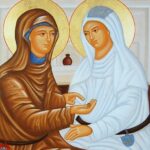Last Updated on May 26, 2024 by Kittredge Cherry
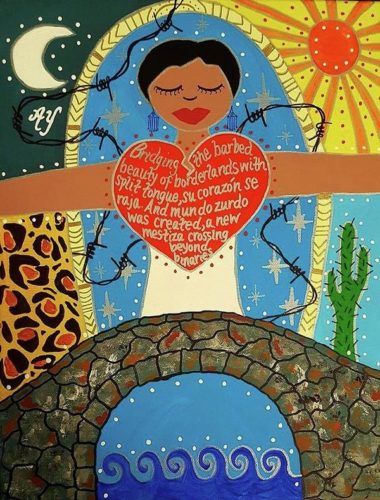
Gloria Anzaldúa is an influential queer Latina feminist scholar whose spirituality often gets overlooked. She died on May 15, 2004 at age 61.
One of the first openly lesbian Chicana writers, she grew up in Texas near the U.S.-Mexico border. In school she was punished when she was caught speaking Spanish, her native language, while Latinx people sometimes criticized her for using English. Her work challenges binary thinking by emphasizing the marginal, mixed (mestizaje) cultures that develop along borders. She also thwarted patriarchal structures in Catholicism through her devotion to folk Catholic female icons such as Our Lady of Guadalupe along with divinities from the indigenous Nahuatl/Toltec and African Yoruba traditions.
“My family, like most Chicanos, did not practice Roman Catholicism but a folk Catholicism with many pagan elements,” she wrote in “Borderlands/La Frontera.”
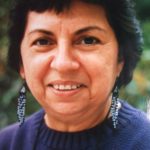
Gloria Anzaldúa (Wikimedia Commons)
Anzaldúa usually identified herself as a lesbian, but she also claimed a queer identity. Her multi-sexuality included relationships with women and men.
Artist Angela Yarber painted Anzaldúa for her Holy Women Icons series. The icon was commissioned by queer theologian Roberto Che Espinoza. The colorful icon shows Anzaldúa on a bridge with eyes closed, arms outstretched and a large heart inscribed with words about her “bridging the barbed borderlands.”
Anzaldúa is best known for two books:
 “This Bridge Called My Back: Writings by Radical Women of Color,” a ground-breaking 1981 collection that she co-edited with Cherrie Moraga in 1981.
“This Bridge Called My Back: Writings by Radical Women of Color,” a ground-breaking 1981 collection that she co-edited with Cherrie Moraga in 1981.
and
![]() “Borderlands/La Frontera: The New Mestiza,” a cultural creative autobiography that blends her personal experience with history, poetry, spirituality and political protest. It was named one of the 100 Best Books of the Century by Hungry Mind Review and Utne Reader.
“Borderlands/La Frontera: The New Mestiza,” a cultural creative autobiography that blends her personal experience with history, poetry, spirituality and political protest. It was named one of the 100 Best Books of the Century by Hungry Mind Review and Utne Reader.
Secular scholars tend to ignore the spiritual foundation of her work, but Anzaldúa encouraged people to combine spirituality with politics to create revolutionary change. She championed “spiritual activism” in her later work.
Her altar collection is presetved at library of the University of California, Santa Cruz. It includes figurines, masks, rattles, pots candles, altar clothes and other objects from the altar that she kept in her home as an integral part of her spirituality and writing. Her work connects with other mujerista or queer Latina liberation theologians such as Marcella Althaus-Reid.
![]() A 2018 book expands on Gloria Anzaldua’s ideas by bringing them into conversation with queer theory and transgender studies. “Post-Borderlandia: Chicana Literature and Gender Variant Critique” by T. Jackie Cuevas examines why gender variance is a core theme in contemporary Chicana and Chicanx narratives. It considers the challenges posed by Chicana butch lesbians and Chicanx trans people.
A 2018 book expands on Gloria Anzaldua’s ideas by bringing them into conversation with queer theory and transgender studies. “Post-Borderlandia: Chicana Literature and Gender Variant Critique” by T. Jackie Cuevas examines why gender variance is a core theme in contemporary Chicana and Chicanx narratives. It considers the challenges posed by Chicana butch lesbians and Chicanx trans people.
Anzaldúa has many admirers and even appears on a variety of Gloria Anzaldúa products at Etsy including T-shirts, coasters, posters and notebooks.
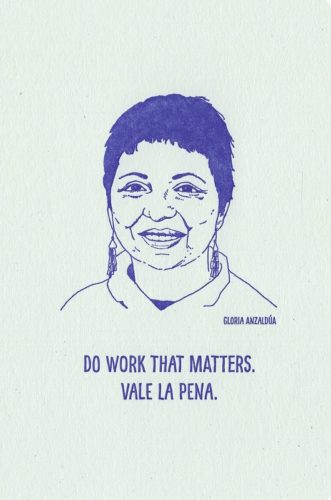
A notebook features Anzaldúa’s face and a beloved bilingual quote: “Do work that matters. Vale la pena.” It was available from the Black Bird Letterpress shop at Etsy.
Holy Woman Icon celebrates Gloria Anzaldúa
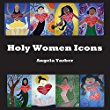 In 2017 Anzaldúa joined the collection of Holy Women Icons painted by Angela Yarber, founder and creative director of the Tehom Center (formerly called Holy Women Icons Project). She is a painter, author, scholar, dancer, minister and LGBTQ-rights activist based in Hawaii and North Carolina. She earned a Ph.D. in art and religion from the Graduate Theological Union at the University of California in Berkeley. Nearly 50 color images of her folk feminist icons included in her book “Holy Women Icons.”
In 2017 Anzaldúa joined the collection of Holy Women Icons painted by Angela Yarber, founder and creative director of the Tehom Center (formerly called Holy Women Icons Project). She is a painter, author, scholar, dancer, minister and LGBTQ-rights activist based in Hawaii and North Carolina. She earned a Ph.D. in art and religion from the Graduate Theological Union at the University of California in Berkeley. Nearly 50 color images of her folk feminist icons included in her book “Holy Women Icons.”
The bold new portrait of Anzaldúa was commissioned by Robyn Henderson-Espinoza, an activist-scholar who identifies as a non-binary trans mixed-raced Latinx. Henderson-Espinoza is visiting scholar at the divinity school of Vanderbilt University in Nashville.
In her essay on the purpose of the icon, Yarber quotes Henderson-Espinoza on why she commissioned it:
“Anzaldúa has always been for me the bridge between theory and action, and her work, both in writing and teaching, compels me to live into my vocation as a public theologian, which at root is bridging across lines of radical difference…. This icon offers me a visual reminder of the ways in which I’m called to be a bridge in curating communities of radical difference.”
“Take up spiritual activism”
Anzaldúa speaks for herself about the holy interconnectedness of life in her essay in the 2002 anthology “This Bridge We Call Home: Radical Visions for Transformation.”
You stand on tierra sagrada (holy ground) — nature is alive and conscious; the world is ensouled…. With awe and wonder you look around, recognizing the preciousness of the earth, the sanctity of every human being on the planet, the ultimate unity and interdependence of all beings — somos todos un paíz (we are all a country/ land). Love swells in your chest and shoots out of your heart chakra, linking you to everyone/everything — the aboriginals in Australia, the crows in the forest, the vast Pacific Ocean. You share a category of identity wider than any social position or racial label. This conocimiento (consciousness) motivates you to work actively to see that no harm comes to people, animals, ocean — to take up spiritual activism and the work of healing.
___
Related links:
Sor Juana Inés de la Cruz: Nun who loved a countess in 17th-century Mexico City
Oración al Cristo del Arco Iris (Rainbow Christ Prayer in Spanish)
___
Top image credit:
“Gloria Anzaldúa” by Angela Yarber
___
This post is part of the LGBTQ Saints series by Kittredge Cherry. Traditional and alternative saints, people in the Bible, LGBT and queer martyrs, authors, theologians, religious leaders, artists, deities and other figures of special interest to lesbian, gay, bisexual and transgender and queer (LGBTQ) people and our allies are covered.
This article was originally published in May 2018 and was most recently updated on May 25, 2024.
Copyright © Kittredge Cherry. All rights reserved.
Qspirit.net presents the Jesus in Love Blog on LGBTQ spirituality.


















